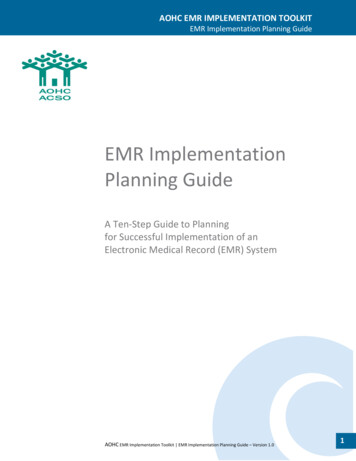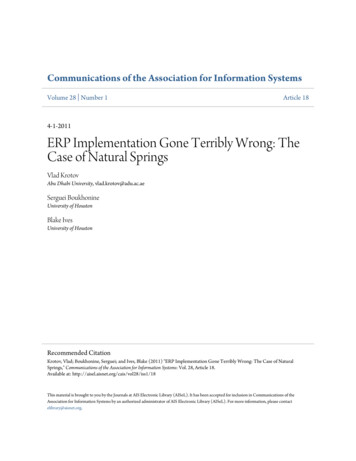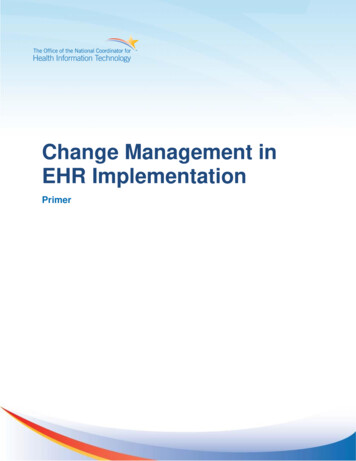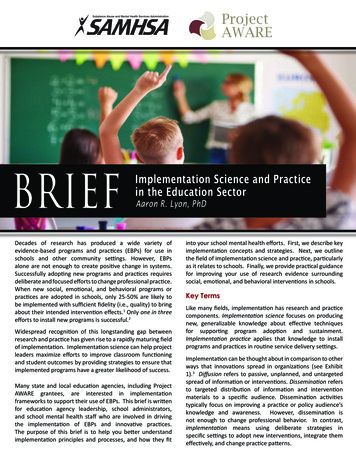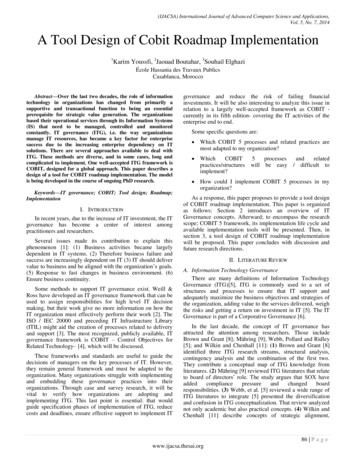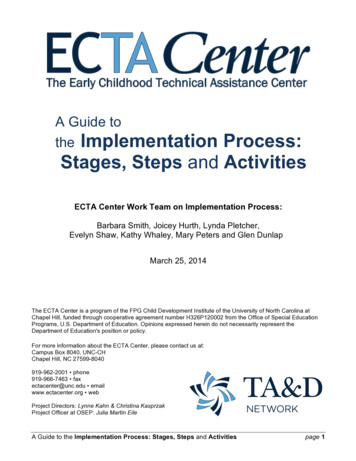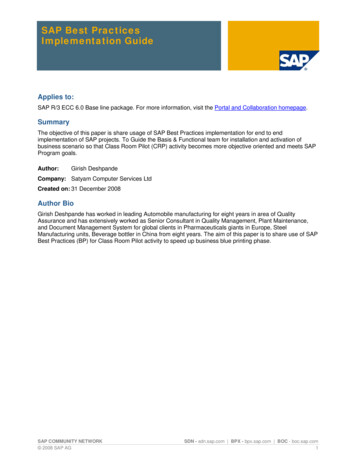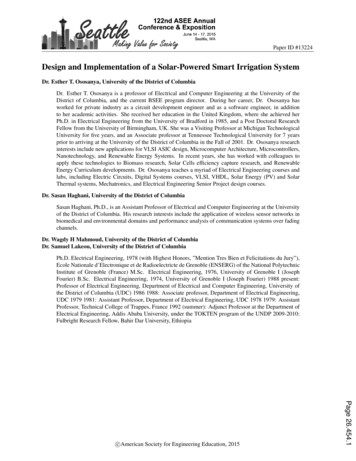
Transcription
Paper ID #13224Design and Implementation of a Solar-Powered Smart Irrigation SystemDr. Esther T. Ososanya, University of the District of ColumbiaDr. Esther T. Ososanya is a professor of Electrical and Computer Engineering at the University of theDistrict of Columbia, and the current BSEE program director. During her career, Dr. Ososanya hasworked for private industry as a circuit development engineer and as a software engineer, in additionto her academic activities. She received her education in the United Kingdom, where she achieved herPh.D. in Electrical Engineering from the University of Bradford in 1985, and a Post Doctoral ResearchFellow from the University of Birmingham, UK. She was a Visiting Professor at Michigan TechnologicalUniversity for five years, and an Associate professor at Tennessee Technological University for 7 yearsprior to arriving at the University of the District of Columbia in the Fall of 2001. Dr. Ososanya researchinterests include new applications for VLSI ASIC design, Microcomputer Architecture, Microcontrollers,Nanotechnology, and Renewable Energy Systems. In recent years, she has worked with colleagues toapply these technologies to Biomass research, Solar Cells efficiency capture research, and RenewableEnergy Curriculum developments. Dr. Ososanya teaches a myriad of Electrical Engineering courses andlabs, including Electric Circuits, Digital Systems courses, VLSI, VHDL, Solar Energy (PV) and SolarThermal systems, Mechatronics, and Electrical Engineering Senior Project design courses.Dr. Sasan Haghani, University of the District of ColumbiaSasan Haghani, Ph.D., is an Assistant Professor of Electrical and Computer Engineering at the Universityof the District of Columbia. His research interests include the application of wireless sensor networks inbiomedical and environmental domains and performance analysis of communication systems over fadingchannels.Dr. Wagdy H Mahmoud, University of the District of ColumbiaDr. Samuel Lakeou, University of the District of ColumbiaPh.D. Electrical Engineering, 1978 (with Highest Honors, ”Mention Tres Bien et Felicitations du Jury”),Ecole Nationale d’Electronique et de Radioelectricte de Grenoble (ENSERG) of the National PolytechnicInstitute of Grenoble (France) M.Sc. Electrical Engineering, 1976, University of Grenoble I (JosephFourier) B.Sc. Electrical Engineering, 1974, University of Grenoble I (Joseph Fourier) 1988 present:Professor of Electrical Engineering, Department of Electrical and Computer Engineering, University ofthe District of Columbia (UDC) 1986 1988: Associate professor, Department of Electrical Engineering,UDC 1979 1981: Assistant Professor, Department of Electrical Engineering, UDC 1978 1979: AssistantProfessor, Technical College of Trappes, France 1992 (summer): Adjunct Professor at the Department ofElectrical Engineering, Addis Ababa University, under the TOKTEN program of the UNDP 2009-2010:Fulbright Research Fellow, Bahir Dar University, EthiopiaPage 26.454.1c American Society for Engineering Education, 2015
Design and Implementation of a Solar-Powered Smart Irrigation SystemAbstractAccording to the Department of Agriculture Economic Research Service, Agriculture is a majoruser of ground and surface water in the United States, accounting for approximately 80 percentof the Nation's consumptive water use and over 90 percent in many Western States.This paper addresses water scarcity and food crisis by designing and implementing a smartirrigation system. It presents the details of a solar-powered automated irrigation system thatdispenses the exact amount of water required depending on the soil moisture, hence minimizingthe waste of water. A network of sensor nodes is used to collect the humidity and temperature ofthe soil which is transmitted to a remote station. This data will be analyzed and used to remotelycontrol the amount of water dispensed by solenoid valves. The designed project is currentlyoperating at the university-owned agricultural experimental research station. The system can betailored to the type of food or crop being grown. The design team incorporated the theory ofdigital control and feedback systems, and digital communication in the design andimplementation of this project.The automated drip irrigation system will help reduce the problems associated with water wastein farming, avoid evaporation, and as a result increase food crop production.I. IntroductionThe Food and Agriculture Organization of the United Nations [1], estimatesthatagricultureaccounts for 70% of all water consumption, compared to 20% for industry and 10% fordomestic. Critical need therefore exists to implement water conservation practices in agriculture.There is an urgent need to create strategies based on science and technology for sustainable useof water, including technical, agronomic, managerial, and institutional improvements.The objective of this project is to develop a system that will minimize the waste of waterin an Agricultural Experiment Station farm. The smart system developed uses automated dripirrigation and uses the exact water required depending on the soil moisture. The farm site hashumidity, temperature, flow sensor, and soil moisture sensors. The data collected is sentPage 26.454.2greenhouses, crops and administration houses. The automated system collects data from the
wirelessly to the cloud. The system is operated in two modes, either in a closed loop controlmode where the microcontroller operates the opening and closing of the solenoid valve for therequired amount of water needed for the crops, based on the average soil moisture reading, or theagronomist remotely use the cloud data to trigger a channel by writing a specific value. The linklocated below the channel is assigned to turn on and off a solenoid valve. Sensor data arecollected using wireless communication to avoid loose running signal wires and cables in thefield.This is a one semester senior capstone project, involving four electrical engineering students.Senior Capstone Projects represent the culmination of the educational experience, integrating theclassroom with real world problems. The students handle open ended engineering problemswhose solutions require a synthesis of engineering knowledge, analysis, creativity, market needs,safety and esthetics. Projects are carried out by students and supervised by instructors andindustry mentors.The rest of this paper is organized as follows. The System Design is presented in Section II.Project Assessment and cost are discussed in Section III. Finally, the paper conclusions areprovided in Section IV.II. System DesignEnergy Use in IrrigationIrrigation requires a significant expenditure of fossil energy both for pumping and deliveringwater to crops. Annually in the U.S., it is estimated that 15% of the total energy expended for allcrop production is used to pump irrigation water [2]. Overall the amount of energy consumed inirrigated crop production is substantially greater than that expended for rain fed crops [2].Solar energy is the most abundant source of energy in the world. Solar power is not only ananswer to today’s energy crisis but also an environmental friendly form of energy. Photovoltaicgeneration is an efficient approach for using the solar energy. One of the applications of thistechnology is used in irrigation systems for farming. Solar powered irrigation system can be asuitable alternative for farmers in this present state of energy crisis. This is a green way forPage 26.454.3energy production which provides free energy after the system is developed. The Photovoltaic
energy generation system used in this project for powering the automated drip irrigation systemis configured as shown in Figure 1.Figure 1: Renewable Energy Power SystemThe central power source is a two-axis solar tracking PV system [3, 4, 5, 6] mounted on agalvanized steel-pole. The photovoltaic array converts solar energy into a 2KW DC electricalpower. The DC power is converted to AC through a 2.4KW, 115V, 60Hz inverter and providesadequate power to the automated irrigation system. In addition, various voltages are derivedfrom the inverter to provide smaller AC voltages (i.e. 24V, 48V) through step-down powertransformers. In the diagram, a 900W (30-300 VDC or AC) submersible pump delivers waterfrom a 90-ft borehole into a 5000-gallon cistern for storing the ground water that will be used forirrigation. The cistern has a solenoid valve, flow meter, and plug-type sprinkler system attached.The battery banks with eight 12V 330AH deep cycle batteries configured as 24V 1200AHprovide backup power for the automated drip irrigation system. The system has an estimated 3 toPage 26.454.45 days of autonomy when there is little or no sun energy.
Soil Moisture Sensor Nodes:Soil moisture sensors measure the water content in soil. Measuring soil moisture is important inagriculture to help farmers manage their irrigation systems more efficiently. Not only are farmersable to generally use less water to grow a crop, they are able to increase yields and the quality ofthe crop by better management of soil moisture during critical plant growth stages. Afterinserting a probe into the soil for approximately 60 seconds a meter indicates if the soil is toodry, moist or wet for plants. The sensor reads the amount of moisture in the soil. The soilmoisture sensors used in this project are the solar powered SHT1x sensor series ICs fromSensirion [7].The Sensor Node Moisture Sensor (SHT1x) Xbee S1 (IEEE 802.15.4) 1 Watt Solar Panel [8]: Power Output: 6V @1W ( 167 mA)Operating temp range: 32 to 158 F (0 to 70 C)Arduino IDEMicrocontroller9V Rechargeable batteryFigure 2: The Soil Moisture Sensor NodesAn energy efficient wireless sensor network is developed using Arduinos microcontroller andPage 26.454.5XBee modules. This allows us to collect a number of different readings from the sensors. The
design uses multiple sensors (SHT1x) strategically placed in a crop zone to collect soil moisturedata. A 1W small solar panel module with a 9V rechargeable battery, powers each sensor node.The soil sensor is interfaced to an Arduino UNO [9] and a Xbee transmitter. Each sensor node isa part of a Zigbee network in a Star topology [10] around a hub controller or concentrator. TheZigBee is a worldwide open standard for wireless radio networks in the monitoring and controlfields. A coordinator radio sits at the center of the star topology and connects to a circle of enddevices, which in this application are the soil moisture sensors. Every message in the systemmust pass through the coordinator radio, which routes them as needed between devices. The enddevices do not communicate with each other directly. The data collected is transmitted wirelesslyto the concentrator which uses an algorithm to smooth out the moisture content in the crop zone.This concentrator is also capable of collecting weather samples such as temperature, humidityand dew point from a weather station using the fully calibrated SHT1x A5Z11 sensor series ICsfrom Sensirion. The SHT11 and SHT1x sensors series are already fully calibrated and outputdigital values, so there is no need for sensor calibration or the use of any Analog to Digitalconversion modules. The sensor power consumption is in the range 8-15µA which is a very lowpower consumption with 2 years longtime stability. Solar panel is implemented in each sensornode to preserve battery life. Temperature sensor in the field is important because the soilmoisture sensor sensitivity is affected by temperature. The reason for this is that soil resistancechanges with temperature.Xbee S1Xbee S1 with antenna has a long range data integrity and 300sq feet of range for the wirelesscommunication. The low power current 45mA at 3.3V helps to have a system which does notdraw too much power out of the battery. These stations are in charge of reading and collectingdata from each sensor and send it as a digital output to the hub.The data collected is sent to the cloud which is then displayed in various forms in this case,tabulated and graphing data accessible on a public website. A PID Process control algorithm isalso developed to process the data received, and then sends trigger signals from the cloud to thesolenoid valve to precisely control the amount of water flow to the soil.Page 26.454.6
Figure 3: The Hub Controller Circuit Schematics and Interface modulesThe hub is configured also with Arduino and Xbee devices as coordinator or concentrator. Thecircuit schematic is as shown in Figure 3. The masters or coordinator stores an average for eachspecific value (i.e., sensor readings) into an Arduino UNO. The hub controller also controls theflow sensor interfaced to the Arduino to measure the volume and velocity of the flow of waterfrom the cistern. The Badger ORION Series 228PV wireless flow sensor system [11, 12] andthe flow meter with its integral microcontroller (SN: 320-0000 model) is used for the water flowmeasurement. This comprises of battery powered flow sensor and a radio frequency (RF)signals approximately every four seconds to the RF receiver. The RF receiver is interfaced withPage 26.454.7transmitter (complete with RF receiver/pulse transmitter). The transmitter sends pulse output
the Arduino. The pulse output is scaled or calibrated to represent the desired volume unit andnumber of output pulses per unit volume. To open and close the solenoid valve for the requiredamount of water needed for the crops, a PID Control algorithm is used; this calculates the errorvalue in the average soil moisture sensor reading as the difference between a measured input anda desired set point. Then, all the average values for each sensor are pushed into the cloud. In thecloud, for remote operation, farm personnel will be able to trigger the data for each valuemanually if required, which means it will turn ON or OFF the solenoid valve depending on theaverage or threshold value assigned for the crop zone soil moisture, usually at 50% of soil MADvalue. In real-time mode, the microcontroller uses average soil moisture sensor readings for 15minutes to determine if to open or close the solenoid valve. SH11 or temperature and humiditysensor is hard-wired to the Arduino Uno and the Xbee to the Arduino Uno for the wirelesscommunication.The Wi-Fi shield [13, 14] used in the project is the TI CC3000 module which is a self-containedwireless network processor that simplifies the implementation of long-range wireless or Internetconnectivity. The TI Wi-Fi network processor minimizes the software requirements of the hostmicrocontroller which makes it the ideal solution for embedded applications using any low-costand low-power microcontroller.Power Consumption: AVR/Sleep ModeArduinos are better to be utilized since it allows easy interface to standard Wi-Fi shields,USB, I2C, power regulation, etc. The disadvantage of the Arduino hardware is the drain onbattery power when it is in operation. Arduino UNO already consumes more than 15mA in idlemode. When powered by 9V alkaline battery which has a 450mAh, the Arduino will drain thebattery within just 30 hours or less than two days (450mAh/15mA). To conserve the batterypower in this application, the sensor node is used in the sleep mode, this means the Arduino willturn on, read from the sensor and transmit the data to the hub. Data is sampled for a few secondsPage 26.454.8
The HUB (SHT1x)-Micro Weather Station Signal-Smoothing Algorithm PID controller algorithm (WDT)-Watchdog timer IOT-Internet of thingsFigure 4: The Hub Waterproof casingbefore putting the system back into the sleep mode. Using this configuration the battery will last6 to 9 months. All batteries are rechargeable, and can be recharged from the renewable powersystem breakout boxes. The hub station runs completely with solar energy and collects the datafrom the different sensor and flow nodes, plus the outside temperature. All these components arelocated inside of a weatherproof pvc box to protect them from any climate change, as shown inFigure 4. This concentrator sends the data to the cloud.Signal-Smoothing algorithm:Page 26.454.9Figure 5: Smoothing the Signal
The simplest form of smoothing a signal is the "moving average" which is when each data valueis replaced with the average of the neighboring values. If we want to avoid shifting the data toget a smooth signal, the best way is to average the same number of values before and after wherethe average is being calculated. In practice, adding more sensors can help the grower understandwhat is happening in the various parts of the field. Also, additional sensors can help average outsome of the field and sensor variability to give a more representative average.PID Controller Algorithm:disturbance(s) Set Point (SP)Process Variables (PV)ErrorProcessPID Controller Measured ProcessVariablesSensorsFigure 6: PID ControllerPID control is very important in distributed control systems. A PID Controller is shown in Figure6 where the set point (SP) is the value that we want the process variable to be. As an example,the control system needs to activate the solenoid valve when the moisture in the field is less than50%. So, the control system in the field may have a SP of about 50% or more of moisture. Thismeans that, we want moisture in the field to achieve a steady moisture value of as close to 50%and more of moisture as possible”. The input to the negative PID is error signal which is thedifference between the set Point (SP) and the measured process variables. If the value of theerror signal is positive, the set point is higher than the measured moisture, then the system willswitch on the solenoid valve and in a couple of minutes the moisture of the crops will increase itsPage 26.454.10level. The solenoid value is turned off when the value of the error becomes negative.
Internet of Things (IOT) [15]:There are many benefits using cloud to store data; the reduction of initial costs for hosting aservice: with cloud computing platforms you do not need to set up the entire appropriatehardware infrastructure (that includes servers, network, routers, etc.) for storing your sensor data.Quality of service and guaranteed availability, the cloud service provider guarantees you nonetwork failures as long as your system is well-developed. Another advantage is that you canhave access anywhere as long as you can have any computer device and internet access. Last butnot least, you do not need to back up your data or create a recovery system. The provider willtake care of backing up your data which had been stored. Cloud services are very easy to use andaffordable for any platform. It provides access to remote services and other applications.The Arduino program in the hub averages the values collected so that it will create a singledigit from the entire field. This number determines whether the soil moisture measured is toodry, too wet, or simply in a proper state. Consequently, this measurement will be pushed into apublic website, displaying all the data collected from the farm which refers to the humidity,moisture, temperature, and gallons measurement. Sample of the cloud reading is displayed inFigure 7.Page 26.454.11
Figure 7: The Cloud ReadingsPhone Apps:A mobile App is developed for this project using the Conduit website services. Conduit is awebsite that allows you to design a mobile App for personal or business purposes. It is one of thean account to get an App code. Based on that code, you can design your App, edit it, andPage 26.454.12top three websites in the market and has great reputations and customer service. The user creates
uploaded on Apple store for apple products access, Google or Samsung market for Androiddevices or on Amazon for amazon tablets. The designed App will allow users to check the statusof the irrigation project online from anywhere for as long as they have internet access. Figure 8shows sample displays from the mobile App.Figure 8: Mobile App DisplaysIII. Project Assessment and Project CostThe senior capstone design projects are assessed based on multiple realistic engineering designconstraints and pertinent engineering standards. The following design constraints were consideredfor the Automated Drip Irrigation System.1.Design a sustainable low-cost, low-power, drip-irrigation system to control and reducewater waste in farming;2.The sub-system should use power from green energy;3.The sub-system should be able to operate in real-time, and remotely without humanintervention;4.Economics should be kept in mind to keep parts and configuration costs as low aspossible;5.The design should be tailored to the type of crops being grown and the landscape;6.Weather conditions are to be taken into consideration.Pertinent Engineering Standards:IEEE STD 100-1984 data communication protocols; Use of IEEE 802.15 communicationprotocol facilitates communication between designers, customers, and vendorsPage 26.454.13
Use of IEEE 802.15 communication protocol standard in compliance with the FederalCommunication Commission (FCC) rules.Cost summary:The project was built using cost-efficient components and can be easily duplicated. A cost summaryis provided in Table 1.Table 1. Project Parts Price ListComponentCost( )Badger Flow meter series 228PV (Donatedby Badger Meter Company)Badger Meter Model 320 PulseTransmitter/Receiver (Donated by BadgerMeter Company)3 way diverter valve564.322xSunfounder 2 channel 5V relay shieldmodules16.988x Arduino UNO boards400.00CC3000 WiFi Breakout with uFLConnector for Ext Antenna8x Xbee shields49.9525256.99440.006x SHT1X Soil Moisture Sensors 1 WattSolar Panels120.001x Liquid Level Sensor40.001 x SHT11 temperature-humidity sensor 1Watt Solar Panel2KW DC Renewable Energy PowerSystem (from previous senior capstoneprojects) 26,000.0019.90Miscellaneous parts100.00Total----- 2,060.14IV. Conclusionsolar energy was presented. The design uses an automatic irrigation system that can be tailored toPage 26.454.14In this paper, the design and implementation of a smart irrigation system, powered by
the type of food crop being grown. The designed project is currently operating at the universityowned agricultural experimental research station.References:[1] Food and Agriculture Organization of the United Nations,http://www.fao.org/nr/water/aquastat/water use/index.stm[2] Derrel L. Martin, Tom W. Dorn, Steve R. Melvin, Alan J. Corr, William L. Kranz. “Evaluating Energy Use ForPumping Irrigation Water”, Proceedings of the 23rd Annual Central Plains Irrigation Conference, Burlington, CO.,February 22-23, 2011, pgs. 104-116.[3] S. Lakeou, E. Ososanya, B. Latigo, et. al, “Design of a Low-cost Solar Tracking Photo- Voltaic (PV) Module andWind Turbine Combination System”, ASEE 06, 2006-1992:[4] S. Lakeou, E. Ososanya, B. Latigo, et. al, “Design of a Renewable Energy Based Power System For a ZeroEnergy Visitors’ Center”, ASEE 07, 2007-2346:[5] S. Lakeou, B. Latigo, et. al, “Design of a Remote Power and Weather Data Monitoring System for a Solar andWind Based Renewable Energy Power Source: Application to a Water Delivery Project in a Rural Community”.,23rd European Photovoltaic Solar Energy Conference & Exhibition, 1-5 September 2008, Valencia, Spain.[6] S. Lakeou, E. Ososanya, A. Laith, C. Quiroga, N. Jessica, S.Diarra, M. Sogbohossou, B. Koukoua, and R.Shrestha, “Solar Powered, Controlled Irrigation System at the UDC Experimental Farm”, 29th EuropeanPhotovoltaic Solar Energy Conference and Exhibition, EUPVSEC2014 Amsterdam, Netherlands, September 22-26,2014, Pgs: ht1x/Internet:[8] Jameco Electronics, “Solar Panel 6 Volt DC @ 167mA”. l-6v-1w-125x63mm-6vdc-output.html[9] Arduino, “Arduino Uno”, Internet: http://arduino.cc/en/Main/arduinoBoardUno.[10] Faludi, Robert. “Building Sensor Networks”. O'Reilly Media: Dec 10, 2014, pgs. 1-292.[11] Badger meter, “Badger Series 228PV Wireless”, Internet: rial-Products/SEN-DS-01535-EN.pdf?[12] Badger meter, “Data Industrial Series 320 Pulse Transmitter”, Internet: 3] Adafruit, “Adafruit CC3000 WiFi Shield with uFL ] Arduino Computer Parts, “Arduino Computer Parts”, Internet:store.com/Sun Founder 2 Channel 5V Relay o.computer-parts-[15] Charalampos, Doukas, “Building Internet of Things with the Arduino”, Lexington, KY, Mar. 2014, ppg 8-342.Page 26.454.15
Design and Implementation of a Solar-Powered Smart Irrigation System Dr. Esther T. Ososanya, University of the District of Columbia Dr. Esther T. Ososanya is a professor of Ele
